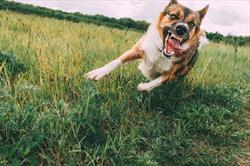Introduction
The diagnosis of primary behavior problems such as anxiety, aggression, or eliminating outside the litterbox is often a diagnosis of exclusion. Because many behaviors result from underlying medical conditions, a change in behavior may be the first sign you see. When behavior changes occur, it is important to have your pet evaluated by your veterinarian, even if that change is subtle. Some common behavioral changes that can indicate a medical disease include:
- sleeping more during the day or trouble sleeping at night;
- moving less;
- pacing, panting, and trouble settling;
- licking people and objects;
- aggressive responses;
- urinary and fecal accidents;
- biting at the air or their sides;
- destructive behaviors;
- chewing, biting, and scratching;
- an increase in sensitivity to noises;
- refusing walks;
- decrease in appetite;
- reluctance to play.
Red Flags and Behaviors
When evaluating the behavior of your pet, there are some “red flags” to watch for that to indicate there may be a medical problem. For example, when an older dog without a history of aggression suddenly snaps or bites, or a middle-aged dog suddenly becomes more fearful of thunderstorms, there may be something more going on. Any recent change or sudden progression of behavior should be investigated, especially if your pet’s environment and schedule have not changed.
Behavior and Illness
Any illness can change behavior. When your pet becomes sick, sometimes a new behavior, such as urinating in the house, will persist even after the illness resolves. In this case, your cat may develop an alternative location for elimination that is more convenient than their litterbox. The same is true with dogs.
Medical Conditions that Change Behavior
Pain has been linked to almost every imaginable behavior change in dogs, such as noise sensitivity, separation anxiety, reactivity and aggression, and exaggerated responses to touch. In cats, pain can result in aggression, hyperesthesia, and overgrooming. In horses, bucking, bolting, or unwillingness to work may indicate pain. If an animal is not limping or crying when moving, pet owners may not consider pain as a contributing factor to their pet’s behavior.
Neurologic conditions are often mistaken for behavior problems. Behaviors that look compulsive in nature (such as fly snapping) can be partial seizures, as can aggression. Certain parasites or viruses can affect the brain and nervous system directly. Problems with movement sometimes appear behavioral when they are neurological in nature. For instance, ataxic (unsteady) dogs may fall or lie down on walks or when they get excited. Neurologic disease is often worsened by excitement or stress, creating a cycle of excitability and fear.
Dermatologic disease is one of the main reasons for behavioral change in many species. Animals with chronic pruritis (itchy) can develop anxiety or act aggressively, particularly when approached by people or other animals. Dermatologic disease can lead to many other behaviors, such as running and vocalization in cats due to hyperesthesia, compulsive licking, or tail chasing.
Gastrointestinal disorders (including pain) can also appear as changes in behavior. Consider gastrointestinal causes such as food allergies, inflammatory bowel disease, or other digestive issues in dogs that guard food in particular. Excessive licking (fly biting) due to nausea is often misdiagnosed as anxiety as well.
Thyroid disease has also been linked to behavior change. Hyperthyroidism (overactive thyroid) will cause increased drinking behavior, activity, and vocalization. Hypothyroidism (underactive thyroid) may result in decreased activity or aggression in some cases. Some scientific studies found thyroid disease to be less of a factor in behavioral changes. Thyroid hormones should be routinely checked with any behavior change, especially if other indicators of thyroid disease are present.
Liver disease can cause lethargy, increased drinking, and a decrease in appetite. When the liver is not functioning well, its role in detoxification and processing of products of digestion is impaired. Abnormal blood vessels can cause products of digestion to bypass the liver altogether (liver shunt). When this happens, toxins build up in the blood and affect the brain (hepatic encephalopathy), resulting in behavior changes such as head pressing, vocalizing, ataxia, seizures, and aggression. These behaviors can worsen after your pet eats, particularly if the meal is high in protein.
Medications such as steroids, hormonal creams, and anti-seizure medications can cause changes in behavior too. Pet owners have reported behavioral changes with antibiotic use, presumably due to changes in gut bacteria. Medications prescribed by veterinarians for behavioral disorders do not directly change behavior; instead, they reduce anxiety and fear by allowing positive behavioral changes to take place.
Conclusion
If your pet experiences an uncharacteristic or sudden change in behavior, it is important to schedule an exam with your veterinarian. Your pet may be experiencing a medical condition that needs to be addressed.




